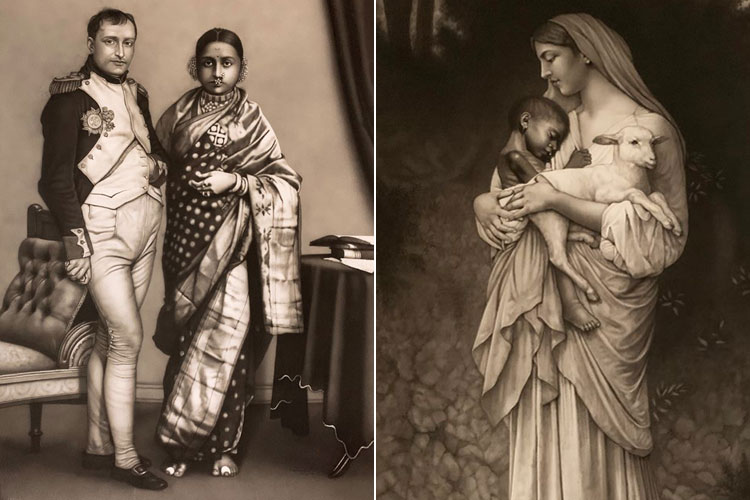Written by: Jovita Alvares
Posted on: March 08, 2019 | 
This work by Farhat Ali seems inspired by Michelangelo's 'Pieta'
Edward Said defined Orientalism as the West patronising representations of the East and through this, highlighted the exoticisation and generic labelling of the ‘Orient’ (East), which was a direct contrast to the ‘Occident’ (West). This ‘way of seeing,’ by the West, exaggerated Eastern cultures as backward, uncivilised and dangerous. Walking into Farhat Ali’s exhibition at Sanat Initiative, one had an almost instantaneous recollection of Said’s words, though it soon became evident that Ali had more of a story to tell.
‘Through the Looking Glass and What Farhat found there,’ opened on 5th March, 2019 and is Farhat Ali’s third solo exhibition. Ali, who graduated from National College of Arts, Lahore in 2015, presents an impressive body of monochromatic paintings, teeming with tales of history, pop and fiction. The works seem to evolve from similar themes that Ali has worked with in the past, where characters from distinct narratives were juxtaposed onto one surface. Much like his previous works, the black and white paintings were charged with humour and iconic imagery that invited the viewer in for a closer look.
Throughout the oeuvre, Ali displays impeccable skill. His attention to detail, form and composition allows each character to seamlessly blend in with the other, causing the viewers to question whether their preconceived account of the character’s narrative was ever accurate. His choice to limit the colour scheme, aided in effortless composites, along with his soft rendering of each painting, made the works resemble vintage monochromatic photographs, thereby further mystifying historic authenticity.
The artist is mindful of not only representing a specific person in his work, but also using the persona they have come to be known for. Judy Garland, as the innocent Dorothy from the Wizard of Oz, is shown by Ali, near a skeevy and unsettling Pran Krishan, who became synonymous with villainy in Hindi films, at a certain time in his career. Disconcert in young Garland’s eyes as she peers at Pran was an astute choice by the artist, as it reinforces the basis of Orientalism.
However, Ali does well to counter this in his other works. One such painting is of Napoleon Bonaparte, the French ruler, who stands proudly next to Anandi Gopal Joshi, the first Indian female to receive a degree in Western Medicine. Historically, both were impactful figures of the 1800s, and though one was more famous than the other, Ali resolves any form of racial bias by depicting them together in a ‘couple-portrait’ painting.

Apart from the iconic imagery, the medium of Indian ink, used by Ali, seems to add another layer to the work. Named specifically for its origins, since it emerged around 4th century B.C. in India, Indian Ink is composed of ash, which gives it its carbon-like colour. He therefore, uses an ink of the Orient onto a paper of French or Occident origin, an amalgam that furthers the narrative the visuals are already dictate.
The title is inspired by Lewis Carroll’s Alice in Wonderland, and just as Alice enters another world of absurdity and otherworldliness, so does the viewer enter Ali’s fantastical realm, which leads to looking at oneself, history and culture, thereby inviting self-realisation. Ali merges narratives to a point of almost near realness, blurring lines between fact and fiction. His oeuvre presents itself as an archive of another world, brimming with its own milieu, making Sanat the exclusive custodian of its mystical secrets.
You may also like: